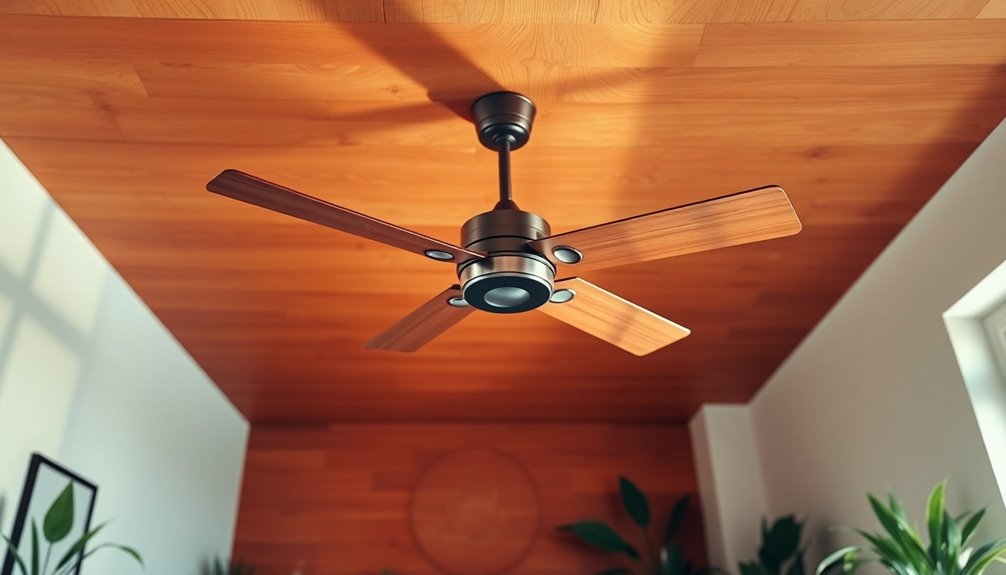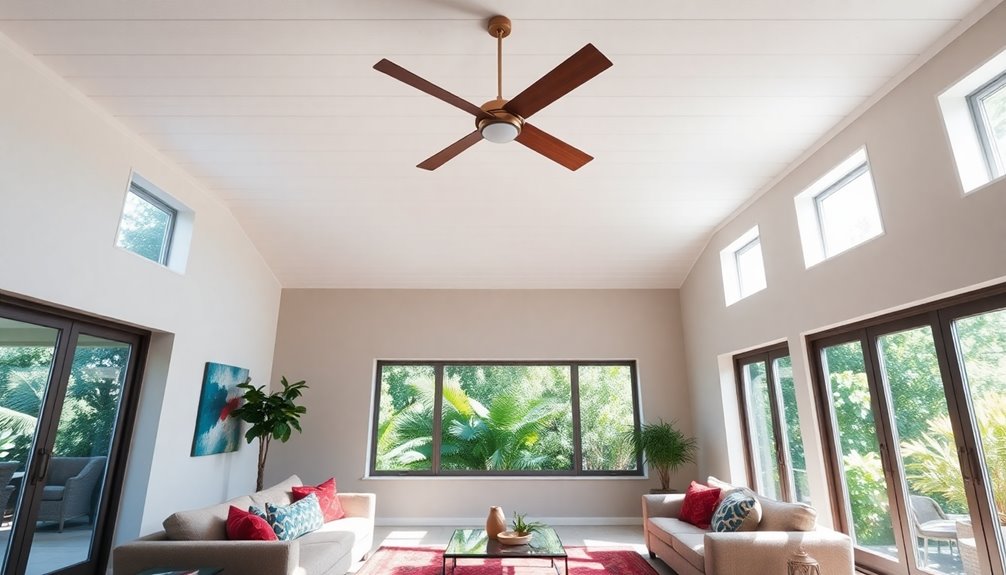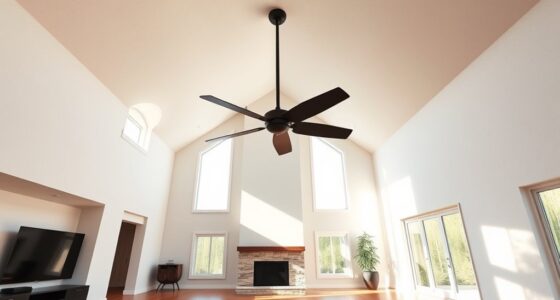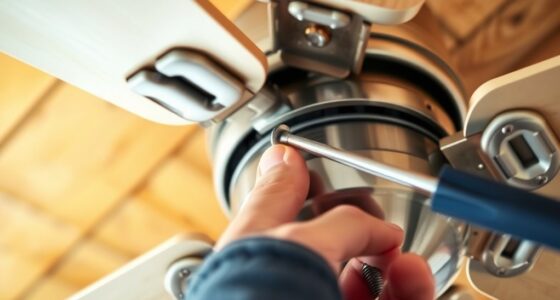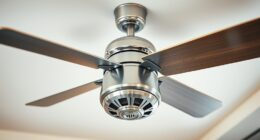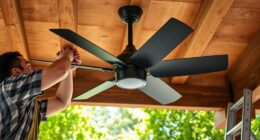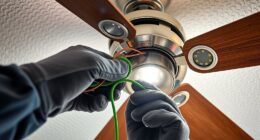A ceiling fan doesn't use much electricity at all. Most standard fans consume between 50 to 80 watts per hour, while energy-efficient models can use as little as 16.2 watts. Running a typical 75-watt fan for 12 hours can cost you about $4.56 a month, which is far less than air conditioning. Plus, when used properly, fans can lower your cooling costs by allowing you to raise your thermostat settings. By understanding how to use them effectively, you can maximize savings and comfort. Keep exploring to discover more tips on optimizing your ceiling fan's usage!
Key Takeaways
- Ceiling fans typically consume between 50-80 watts per hour, significantly less than air conditioning units which use up to 3,500 watts.
- Running a standard 75-watt ceiling fan for 12 hours costs about $4.56 monthly, making them a cost-effective cooling option.
- Energy-efficient ceiling fans can operate on as low as 16.2 watts, reducing monthly electricity costs to around $1.29.
- Regularly turning off ceiling fans when not in use further minimizes electricity consumption and helps save on energy bills.
- Proper usage, such as running fans counterclockwise in summer, enhances efficiency and comfort while reducing energy costs.
Ceiling Fan Power Consumption

When you consider cooling your space, ceiling fan power consumption plays an essential role in your energy bills. Understanding how much electricity your ceiling fan uses can help you make smarter choices.
A standard ceiling fan typically consumes between 50 to 80 watts per hour, depending on the model and speed setting. However, if you opt for an energy-efficient ceiling fan, you could reduce that to as little as 16.2 watts, leading to significant savings in electricity consumption.
For instance, running a 75-watt ceiling fan for 12 hours would use about 900 watt-hours, or 0.9 kWh of energy. On average, this translates to an annual cost of around $18.77 if you operate it for 8 hours a day at the current rate of $0.169 per kWh.
Compared to air conditioning units that can consume up to 3,500 watts, ceiling fans provide a much more energy-efficient cooling option. By being aware of the power a ceiling fan uses, you can enjoy a comfortable environment without breaking the bank on energy costs.
Wattage by Fan Size

When choosing a ceiling fan, the size greatly impacts its wattage.
Small fans, like the 30-inch models, typically use around 100 watts, while larger fans can consume even more, depending on their size and design.
Understanding these differences helps you select the right fan for your space and manage your energy usage effectively.
Small Fan Wattage
Small ceiling fans, typically around 36 inches in size, are known for their efficiency, consuming about 55 watts per hour at maximum speed.
If you're looking to save on your electricity bill, understanding small fan wattage is essential. These fans generally have lower energy consumption compared to larger models, making them cost-effective options for cooling your space.
Here are some key points to keep in mind:
- Energy-efficient models can operate on as little as 38 watts at high speed.
- Power consumption varies based on design and motor type, so always check the manufacturer's specs.
- Using a small fan can help you rely less on air conditioning, leading to less electricity usage overall.
- The ceiling fan cost can be offset by the savings on your energy bill.
Large Fan Wattage
Larger ceiling fans offer a different wattage profile compared to their smaller counterparts. If you're considering a fan for a bigger space, it's crucial to understand how wattage impacts energy efficiency and electricity usage.
For instance, a 42-inch ceiling fan typically consumes between 60 to 75 watts, making it a solid choice for medium-sized rooms. If you need something larger, a 48-inch fan usually runs around 70 to 90 watts, providing effective airflow for larger living areas.
When you step up to a 52-inch fan, expect the wattage to range from 70 to 100 watts. This size accommodates larger rooms while still focusing on energy efficiency.
If you're looking for a fan for a small nook, a 30-inch model uses about 100 watts, but it's better suited for confined spaces. Meanwhile, a 36-inch fan can vary between 50 to 75 watts, depending on its design and motor efficiency.
Hourly Energy Use

Understanding how much energy a ceiling fan uses hourly can help you make informed decisions about your cooling options. Ceiling fans typically consume between 50 to 80 watts per hour, depending on their size and speed settings.
For instance, if you operate a 75-watt ceiling fan for 6 hours, it will use about 0.45 kilowatt-hours (kWh) of electricity. This translates to an electricity cost of approximately $0.05 per day if you run it for 8 hours.
Here are some key points to evaluate:
- Ceiling fans use less power than air conditioning units, which can draw up to 3,500 watts.
- A ceiling fan with lights can consume between 175 to 200 watts per hour, increasing its hourly energy use.
- The average electricity rate is around $0.169 per kWh.
- Choosing a ceiling fan over an air conditioner can lead to significant savings in energy costs.
Daily Energy Consumption

When you think about cooling your space efficiently, daily energy consumption of a ceiling fan is an essential factor to take into account. A standard ceiling fan uses about 75 watts per hour, which means that if you run it for 12 hours a day, it consumes around 0.9 kWh. This results in a daily cost of about $0.15 at an average electricity rate of $0.169 per kWh.
To help you visualize the energy consumption and cost, here's a quick breakdown:
| Duration | Energy Consumption (kWh) |
|---|---|
| 1 Hour | 0.075 kWh |
| 6 Hours | 0.45 kWh |
| 12 Hours | 0.9 kWh |
| Daily Cost | $0.15 |
| Monthly Consumption | 27 kWh |
When you compare this with air conditioning, which can consume up to 3,500 watts, it's clear that ceiling fans represent a notably lower daily energy consumption. By choosing a ceiling fan, you're opting for a more cost-effective cooling solution, saving both electricity and money in the long run.
Monthly Electricity Costs

Over the course of a month, the electricity costs associated with running a ceiling fan can be surprisingly low. For example, a standard 75-watt ceiling fan, when used for 12 hours daily, consumes about 27 kWh each month, costing you roughly $4.56 at an average electricity rate of $0.169 per kWh.
If you opt for a more energy-efficient fan that operates at just 38 watts, your monthly costs can drop considerably to around $1.29.
Here are some key points to take into account:
- Ceiling fans are far cheaper to operate than air conditioning units, which can cost over $81.50 annually.
- Regular use of ceiling fans can save you about $18.77 a year compared to other cooling appliances.
- The efficiency of fans means you can enjoy cool air without breaking the bank.
- Choosing the right fan can make a substantial difference in your monthly electricity costs.
Comparing Fans and Appliances

Ceiling fans stand out as one of the most energy-efficient cooling solutions available, especially when you compare them to other appliances in your home. The power consumption of a ceiling fan typically ranges from 50 to 80 watts per hour, while air conditioners can draw a staggering 3,500 watts.
This stark difference means that running a ceiling fan for six hours costs you about 5 cents a day, in contrast to an air conditioner, which can hit around $1.20 for the same duration.
If you opt for a high-efficiency ceiling fan, you'll see even greater energy savings, consuming only about 16.2 watts and costing roughly $8 a year.
On the other hand, box fans can vary greatly in energy consumption, with some models using up to 110 watts and costing you around $54 annually.
Even tower fans, while more efficient than air conditioners, consume around 48 watts, leading to fan costs of approximately $24 a year.
Energy Efficiency Tips

When it comes to maximizing your ceiling fan's efficiency, choosing Energy Star-rated models can make a huge difference in energy consumption. Additionally, using energy-efficient heat pumps for your home's heating and cooling needs can further reduce overall electricity usage. Heat pumps can reduce energy consumption by up to 50%, leading to significant cost savings on utility bills. Furthermore, geothermal heat pumps can achieve efficiency ratings of 300% to 600%, making them a top choice for eco-conscious homeowners. Air purifiers that utilize HEPA filter technology can also improve indoor air quality, complementing your energy-efficient choices. Don't forget to turn off the fan when the room's unoccupied, since they cool people, not spaces. Incorporating unique decor items like Indonesian Decor Masks can enhance the overall aesthetic of your living space while complementing your energy-efficient choices. These simple steps can help you save on your electricity bills while staying comfortable.
Selecting Energy Star Models
In today's energy-conscious world, selecting an Energy Star-rated ceiling fan can make a significant difference in your electricity usage and costs.
These energy-efficient fans are about 60% more effective than non-rated models, which means reduced electricity consumption and lower annual operating costs. In fact, proper installation of heat pump systems can further enhance energy efficiency in your home. Additionally, using air purifiers in conjunction with ceiling fans can improve overall indoor air quality while further reducing energy costs. Heat pumps can reduce energy bills by up to 50%, highlighting the importance of integrating various energy-efficient systems. Moreover, outdoor ceiling fans can also contribute to energy savings when used in exterior spaces.
With Energy Star fans, you could spend around $8 per year compared to up to $20 for conventional options.
When choosing the right ceiling fan, keep these tips in mind:
- Look for the Energy Star label: It indicates compliance with strict energy efficiency guidelines.
- Consider airflow and comfort: Energy-efficient fans provide better airflow, allowing you to raise your thermostat settings by 4°F without sacrificing comfort.
- Regular maintenance: Cleaning and maintaining your Energy Star model can enhance its efficiency and prolong its lifespan. Regular lubrication with the right oils can also prevent mechanical issues and ensure smooth operation.
- Check specifications: verify the fan meets your specific needs, including size and design.
- Additionally, modern Energy Star certified fans can significantly reduce reliance on air conditioning, enhancing both comfort and energy savings.
Turn Off When Unused
Maximizing the benefits of an Energy Star-rated ceiling fan involves not just choosing the right model, but also using it wisely. One of the simplest yet most effective ways to save electricity is by turning off your ceiling fan when you're not in the room.
Fans typically consume between 50 to 80 watts per hour. If you leave it running for 8 hours a day unnecessarily, it can add up to about $18.25 annually for a standard fan. By regularly turning off the fan when you leave, you're not just cutting down on your electricity consumption, but also promoting more sustainable energy use. Additionally, improving indoor air quality can enhance your comfort when the fan is in use. Proper installation of ceiling fans can also increase their overall efficiency and effectiveness in cooling.
To enhance your energy efficiency, consider utilizing timers or smart controls. These features can automatically turn off the fan when it's not needed, ensuring you don't waste energy. Additionally, using energy-efficient appliances can further reduce your overall electricity usage and contribute to lower utility bills.
Seasonal Fan Direction

Adjusting your ceiling fan's direction according to the seasons can make a noticeable difference in comfort and energy costs.
In the summer, you want your fan to run counterclockwise, creating a cooling breeze that allows you to raise your thermostat by 4°F without feeling uncomfortable. This simple adjustment helps circulate the air effectively.
During winter, switch the fan to run clockwise. This helps circulate warm air that naturally rises, enhancing the efficiency of your heating system. By properly adjusting the fan's seasonal direction, you could save about 30% on heating costs, making it easier to use less electricity overall.
Here are some quick tips to remember:
- Use the fan counterclockwise in summer for a cooling effect.
- Reverse to clockwise in winter to circulate warm air.
- Most fans have a switch or remote for easy direction changes.
- Combining your fan with HVAC systems reduces reliance on air conditioning and heating.
Benefits of Ceiling Fans

While many people rely on air conditioning to stay comfortable, ceiling fans offer a cost-effective alternative that greatly reduces electricity usage. Using only 50 to 80 watts per hour, an energy-efficient ceiling fan costs about $18.77 per year when used for eight hours a day. This is a fraction of what you'd spend on air conditioning, allowing you to enjoy cool breezes without worrying about your energy bills. Additionally, using ceiling fans can lower carbon emissions while maintaining comfort. Heat pumps utilize the refrigeration cycle to transfer thermal energy, showcasing the importance of efficient energy systems. Portable camping toilets can also help reduce water consumption in outdoor settings, highlighting the importance of efficiency in home appliances.
Ceiling fans enhance indoor comfort by effectively circulating air, making hot spaces feel cooler and helping to distribute warmth during winter months. You can even raise your thermostat setting by up to 4°F without sacrificing comfort, further reducing energy bills. Additionally, many homeowners are discovering the advantages of using energy-efficient appliances, which further contribute to lower electricity costs.
Besides their efficiency, many ceiling fans come in various styles and designs, blending functionality with aesthetic appeal. You can find a fan that matches your home decor while reaping the benefits of lower electricity usage.
Frequently Asked Questions
How Much Does It Cost to Run a Ceiling Fan 24 Hours a Day?
Running a ceiling fan for 24 hours a day costs you about $0.30.
This is based on a standard 75-watt fan, which consumes 1.8 kWh daily.
Over a month, that adds up to around $9.12.
If you choose an energy-efficient model, you could spend even less, sometimes as little as $0.04 per hour.
Can Ceiling Fans Cause High Electric Bill?
Imagine a gentle breeze on a sweltering summer day, bringing comfort without breaking the bank. You might wonder if ceiling fans can lead to high electric bills.
The truth is, they're quite economical compared to air conditioning. If you use them wisely—turning them off in empty rooms and adjusting your thermostat—you'll keep your costs low.
With energy-efficient models, your electric bill can stay as invigorating as that cool breeze.
Does Leaving a Ceiling Fan on Use a Lot of Electricity?
Leaving a ceiling fan on doesn't use a lot of electricity, but it can add up over time.
Typically, it consumes about 75 to 100 watts per hour. If you run it continuously, you're looking at around $0.12 to $0.20 a day, depending on your electricity rates.
Is It Cheaper to Run a Ceiling Fan or AC?
You might think air conditioning is the way to go for staying cool, but running a ceiling fan is actually much cheaper.
While AC units can skyrocket your energy bill, ceiling fans typically cost only a few cents per day.
By using a fan, you can enjoy comfort at a fraction of the cost, making it a smart choice for your wallet.
Combine them for even greater savings without sacrificing comfort!
Conclusion
In the grand tapestry of home comfort, ceiling fans weave an energy-efficient thread that cools you without breaking the bank. You'll find that their low power consumption is a refreshing change, especially when compared to other appliances. By harnessing the gentle breeze they create, you can enjoy a cozy home year-round while keeping those electricity bills in check. So, why not let a ceiling fan be your trusty ally in comfort and savings?
